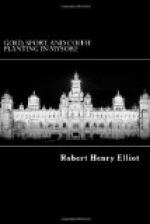After such an application of manure as I have above advised, the planter must be on his guard against producing such a heavy crop as will lead to an exhaustion of the tree, and a failure of the following crop. And should there be reason to apprehend an over heavy crop, it must be reduced by free handling and pruning.
In the case of a neglected plantation the trees are sure to be covered with moss and rough dead bark, and it is of great importance to remove this at once, and rub the trees down thoroughly.
When manuring, always leave here and there, and at some convenient point or edge of a road, a short block of coffee un-manured, perhaps about twelve trees, and next to that a similar block with double the dose of manure applied to the field, and note the results. In order to have the effects of the different systems of manuring under constant observation experiments with different manurial mixtures can be best conducted at places where four roads meet. I need hardly say that in the observation of results, nothing should be left to memory, but the planter, the moment he has observed any result, should on the spot write it in his note book. The experiments of most importance are the following:—(1) As to the manure best calculated to bring on vacancy plants rapidly in old and worn soil. (2) To determine the value of potash as manure. (3) To determine the best time of year for manuring. (4) To determine how far it pays to manure little and often, as compared with manuring seldom but in large quantities. (5) How far the value of bones is due to their lime, and how far to the phosphoric acid they contain; and (6) how far it would pay to top dress old soil with earth taken from the adjacent, grass lands. Such are some of the many experiments that might usefully be tried. It would also be useful to experiment as regards native manurial practices. For instance, the growers of Areca nut palms, and pepper vines, make a mixture of Kemmannu, or red, or rather pink hued soil, which looks like recently-decomposed rock, black earth, and sheep dung, and apply the compost to their palms and pepper-vines, and it would be interesting to try such composts in the case of coffee. It would also be interesting to experiment with ordinary good soil taken from the grass lands. I am informed by a native farmer that the terraces on which ragi is grown, are occasionally dressed with such soil, and that the manurial effect of it lasts for two years, but no doubt the effect is much increased by the physical effect caused by the addition of the soil. The more I have studied these subjects the more am I convinced that the most, economical way of keeping up coffee land from a physical and chemical point of view is one of the many secrets yet to be discovered, and I would strongly urge planters to experiment. There is a common saying amongst farmers and planters that they cannot afford to make experiments. This is merely the refuge of the indolent and the ignorant. Experiments may, of course, be made on such a scale as to be hazardous or even ruinous, but they can be made in such a way as to be neither the one nor the other.




